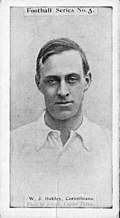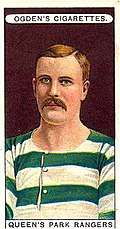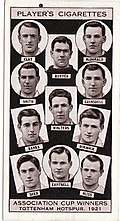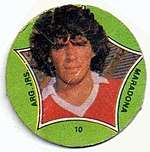Association football trading card
An association football trading card is a type of trading card relating to association football, usually printed on cardboard, silk, or plastic.[1] These cards feature one or more players, clubs, stadiums, or trophies. Football cards are most often found in Europe, Asia and South America.

Some notable producing companies include Panini Group (which has published cards of all FIFA World Cup since 1970 and has presence in more than 120 countries)[2] and Topps (the UEFA Champions League, MLS and English Premier League).
History
Early cards

The first football cards were produced in 1896 by the Marcus & Company Tobacco in Manchester, England. The set consisted of over 100 cards and was issued under the title of "Footballers & Club Colours". They featured illustrated images of players on the front of the card, and a tobacco advertisement on the back of the card. The tobacco companies soon realised that sports cards were a great way to obtain brand loyalty. Production of football cards spread over the United Kingdom. Other football sets issued at that time were released by other tobacco manufacturers such as Kinner (1898), Ogden's (1902), J.F. Bell (1902), F.J. Smith (1902), W.D. & H.O. Wills (1902), Percy E. Cadle (1904) and Singleton & Cole.[3]

One of the first full-colour sets was released in 1906 by Ogden's. The set of cards depicted illustrations of footballers in their club shirts. The set (properly named "Football Club Colours") featured clubs Everton, Aston Villa, Wolverhampton Wanders, Newcastle United, Blackburn Rovers, Middlesbrough, Tottenham Hotspur, Sheffield United and Arsenal. The following year, Cohen Weenen published a similar series entitled "Football Club Captains". This included captains of lower divisions teams of English football.[3]
Taddy & Company introduced the oval-shaped images on its cards, with the collection "Prominent Footballers" of 1907 that consisted of 595 cards. Other cards manufacturers were Churchman's cigarettes, that in 1914 launched an illustrated series featuring action pictures with individual portraits as inserts, and Godfrey Phillips Ltd. (a tobacco company from India, a British colony by then) and Lacey's.[3]
Argentina is probably the oldest producer of football cards in South America, when local tobacco company "Cigarrillos Monterrey" released a series about Primera División teams. Cards showed full-colors illustrations of players in their club colours. Another popular series was released in 1925 by "Cigarrillos Dólar", with hand-colored photographs of players and teams. In 1926, another cigarettes brand, "Cigarrillos Plus Ultra", released a set of cards featuring photos of teams and players.[4]
Consolidation

Taking advantage of the rise popularity of football cards in the 1920s, Godfrey Phillips released collections in 1920, 1922 and 1923. Lacey's also produce its own series of cards in 1925. Ogden's reintroduced the illustration in card with the "Captains of Association Football Clubs and Colours" series with paintings of players that captained in their respective clubs. Following the trend, John Player & Sons (or "Player's"), produced three consecutive series of illustrated cards: the first in 1926 consisting in caricatures of notable players by R.P. Hill (signed as "RIP"), another with caricatures by cartoonist George Douglas Machin (signed as "MAC") in 1927, and the last in 1928 (with no artist credited).[5][3]
In 1928, Gallaher published the "Football in Action" series, depicting illustrated scenes of matches in England. Another illustrated series by Player's came in 1934, "Hints on association football", it consisted of illustrations where some football movements (kicks, passes, defensive tactics, etc.) were shown. Gallaher released the series "Footballers in Action" in 1928. In 1930, Player's brought photograph to cards again with the series "Cup Winners", that homaged FA Cup winners teams of the past, although other companies continued printing illustrated cards in their new collections, such as Lambert & Butler (1931) and Carreras (1934, 1936), Godfrey Phillips (1934, 1936), Ardath (1934), W.D. & H. O. Wills (1935, 1939), Ogden's (two collections in 1935, the first featuring players of both sports, association football and rugby league, all illustrated by Machin).[5] Photographs returned with Churchman in 1938 and 1939.[3] The outbreak of the Second World War caused a severe shortage of paper, and tobacco companies were forced to bring an end to the production of cigarette cards.[3]
In the 1940s Argentine manufacturers introduced smaller, circular-shaped cards, such as "Figuritas Bicicleta" in 1949 that featured photos of footballers and illustrations of clubs' badges. Other companies that produced circular cards were "Starosta", "Lali" and "Sport" and "Gran Crack" in the 1950s, followed by "Deportito", "Fulbito", "Golazo" and "Campeón" in the 1960s.[4]
In 1967, "Figuritas Sport" collection introduced players' caricatures for the first time in Argentina. Those were drawn by artist Jorge de los Ríos (who was also the artist of children magazine Anteojito for the most part of its run).[6] De los Ríos' depictions of players would become a classic in football cards during the 1960s, 1970s and 1980s.[7] The breakthrough in Argentine card industry came in 1970 when the first metallic circular cards began to be marketed in the "Chapitas" album. They were promoted as "El golazo del año" ("Goal of the year").[8]
Modern era

Italian company Panini started to produce football cards in 1961, when the company released a collection set about Serie A. Since then, Panini has been producing football cards until consolidating as the world's leading manufacturer.[9]
In 1970 Panini began publishing L'almanacco Illustrato del Calcio Italiano (The Illustrated Guide to Italian Football), after purchasing the rights from publishing house Carcano. Panini also published its first FIFA World Cup sticker album for the 1970 World Cup in Mexico, in addition to using multilingual captions and selling stickers outside of Italy for the first time.[10] Initiating a craze for collecting and trading stickers, Panini's stickers were an instant hit, with The Guardian stating in the UK "the tradition of swapping duplicate [World Cup] stickers was a playground fixture during the 1970s and 1980s".[11][12] Another first for Panini, in the early 1970s, was introducing self-adhesive stickers, as opposed to using glue.[13][14]

In Spain, the first collection released by Panini was the 1974 World Cup album.[2] The Spanish market introduced digital collections when Stampii, an internet company established in 2009, released one year later its first set of digital trading cards. Collectors were allowed to acquire sets or share their collections only through the web.[15][16]
In the United States, Upper Deck (established in 1988), released a series for the 1994 World Cup featuring several sports personalities that promoted the competition. The same company launched several collections after a deal with Major League Soccer (MLS) in the 2000s.[17] Another US company, Pacific Trading Cards, produced MISL/indoor soccer cards in the 1980s and 1990s.[18] Moreover, Pro Set was licensor of the English Premier League for its football cards of 1990–91. Wizards Of The Coast also had a brief stint producing Premier League players cards in 2001–02.
Asian manufacturers include Futera, a United Arab Emirates company established in 1989 that got licenses of some of the most notable English clubs.[19]
In May 2006, Panini partnered with The Coca-Cola Company and Tokenzone to produce the first virtual sticker album for the 2006 World Cup. The album was viewable in at least 10 different languages, such as Portuguese, Dutch, English, French, German, Greek, Italian, Japanese, Korean and Spanish.[20] For the 2014 World Cup, three million FIFA.com users took part in the Panini Digital Sticker Album contest.[21] Panini developed an app for the 2018 World Cup where fans could collect and swap virtual stickers.[22] Five million people gathered digital stickers for the 2018 World Cup.[23]
During the 2018 World Cup, Panini produced an average of 8 and 10 million card packages per day.[24] In 2018, Panini signed a deal with English Premier League to produce cards under license since the 2019–20 season.[25]
Manufacturing companies
Past
Most of the past producers companies are defunct of have left the trading card business, they were:[3]
- Marcus & Company: 1896
- Wills: 1902, 1935, 1939
- Singleton & Co.: 1905
- Ogden's: 1902, 1906, 1926, 1935
- Cohen Winnen: 1907
- Tadddy & Co.: 1907
- Churchman: 1909, 1914, 1938, 1939
- Godfrey Phillips: 1920, 1922, 1923, 1934, 1936
- Lacey's: 1925
- Player's: 1926, 1927, 1928, 1929, 1934
- Gallaher: 1928
- Lambert & Butler: 1931
- Carreras: 1934, 1936
- Ardath: 1934
- Pacific: 1980s–1990s[18]
- Pro Set: 1990–91
- Upper Deck: 1993–2012
- Stampii [note 1]
- Wizards Of The Coast: 2001–02
- Select Australia: 2007–10 [26]
Current
Companies that currently produce football trading cards are:
| Company | Establ. | Licenses |
|---|---|---|
| Futera | 1989 | Premier League [note 2], National Soccer League[note 3], "World Cup Greats" [note 4] |
| Panini | 1961 | FIFA World Cup, UEFA Champions League, Copa América, Premier League,[27] La Liga,[28] Serie A,[29] Argentine Primera División[30] |
| Topps | 1938 | Bundesliga, MLS, Premier League, UEFA Champions League[31] |
Gallery
 Ferro Carril Oeste, Argentine card, c. 1911
Ferro Carril Oeste, Argentine card, c. 1911 Churchman card of 1914
Churchman card of 1914 "Cup Winners" series by Player's, 1930
"Cup Winners" series by Player's, 1930 "Hints on association football" by Player's, 1934
"Hints on association football" by Player's, 1934 T. Walker, card by Godfrey Phillips Ltd., 1936
T. Walker, card by Godfrey Phillips Ltd., 1936 Arthur Tutin on a Churchman card, 1938
Arthur Tutin on a Churchman card, 1938
See also
Notes
- Stampii was an internet company established in 2009 that released digital cards only.[15][16]
- Futera's Premier League licenses include Liverpool, Arsenal, Manchester City, Manchester United, Chelsea, Leeds, Aston Villa, West Ham, Celtic, Newcastle, Derby County, Middlesbrough
- Soccer league of Australia, defunct in 2004.
- Great and legendary players of the FIFA World Cup. Some of the "legends" included in the collection are Carlos Alberto, Gordon Banks, Franz Beckenbauer, Bobby Charlton, Johan Cruyff, Eusebio, Garrincha, Mario Kempes, Diego Maradona, Pelé, Michel Platini, Ferenc Puskás, Romario, Karl Rummenigge, among others.[19]
References
- "Not Always Cardboard: Unusual Materials Used to Make Trading Cards". Sports Collectors Daily. 2016-02-10. Retrieved 2017-04-22.
- Paninimanía: los secretos de la empresa dueña de las figuritas by Jaime Hancock, La Nación, 25 Apr 2018
- The History of Football Cigarette Cards by John Simkin, on Spartacus Educational, September 1997
- Figuritas de fútbol / Primera parte: 1926-1967 on "Paladar Negro" website, 27 Nov 2012
- George Douglas Machin biography and work on Dallington History website
- La conmovedora historia del caricaturista detrás de García Ferré by Alana Gorski, 4 Nov 2016
- La historia detrás de una figurita by Pablo Calvo, Clarín, 25 Aug 2018
- Figuritas de fútbol, segunda parte (1968-71) on Paladar Negro
- La historia del fútbol cabe en los cromos, El País
- "Brand collaborations". FIFA.com. Retrieved 8 September 2018.
- "Panini World Cup sticker book". The Guardian. Retrieved 3 September 2018.
- "The Magic, Global Craze and Tradition of Panini's World Cup Sticker Albums". Sports Illustrated. Retrieved 2 September 2018
- "Panini: FAQ". Panini Group. Retrieved 2010-04-18.
- "Fifty Years of Italian History Through Famous Album". ANSA. Retrieved 2010-04-18.
- La española Stampii lanza colecciones de cromos digitales by Javier Martín on El País, 8 Apr 2010
- Stampii, coleccionismo multimedia que aprovecha al máximo las TIC by Nacho Azcona on Sportics, 4 Apr 2012
- Upper Deck Releases 2011 Soccer Set Featuring Company's Newest Exclusive Spokesman, Landon Donovan! on Upper Deck website, 26 Apr 2011
- MISL Pacific Trading Cards on Soccer Americana website
- Football checklist on Futera website
- "Coca-Cola and Panini Launch First Digital Trading Platform: Officially Licensed Football Stickers for 2006 FIFA World Cup Germany". Coca-Cola. Archived from the original on 2010-01-10. Retrieved 2010-04-18.
- "Panini Digital Sticker Album launched for Russia 2018". FIFA.com. Retrieved 8 September 2018.
- "Panini World Cup sticker album: Inside story behind the craze". Sports Illustrated. Retrieved 5 October 2018.
- "12 Years Running: Panini's FIFA World Cup™ Digital Sticker Album is More Popular Than Ever". Coca-Cola Company. Retrieved 5 October 2018.
- Negocio multimillonario: así funciona la fábrica de figuritas de Panini
- Panini lands Premier League league card on Beckett website
- Soccer cards on Select Australia
- Panini on Premier League
- El álbum oficial de LaLiga Santander 2019-20! on Mundo Deportivo
- Calciatori Collezione on Panini Italia
- Álbum Oficial del Fútbol Argentino Superliga on Panini Argentina
- Soccer Trading Cards on Topps website
External links
| Wikimedia Commons has media related to Association football collectible cards. |
- Panini Group
- Football cards on Topps UK site
- Soccer cards on Topps (archived, 28 Feb 2017)
- Futera
- Soccer cards on Select Australia
.svg.png)